Manifest Technology Blog
-- Site:
| Articles
| Galleries
| Resources
| DVI Tech
| About
| Site Map
|
Articles:
| PC Video
| Web Media
| DVD & CD
| Portable Media
| Digital Imaging
| Wireless Media
| Home Media
| Tech & Society
|
PC Video: |
PC Video Articles |
Video Software Gallery |
Video Editing Resources |
Mass-Market Digital Video and DVD (3/2003)
(Microsoft Movie Maker 2,
Sony Screenblast Movie Studio,
Topics Instant DVD Maker)
by Douglas Dixon
Microsoft Movie Maker 2 - AutoMovie
- Windows Media Editing
Sony Screenblast Movie Studio
Topics Entertainment Instant DVD Maker
Mass Market Video - References
Messing around with digital media on your computer is getting mighty easy
these days. First it was digital audio, to build and enjoy your own custom music
collections, and then digital photography, to store and organize photos so you
could edit and share them. Not only has the equipment dropped dramatically in
price, but the necessary connections and software are now built in to the basic
computer platforms, and available out of the box on the Macintosh and under
Windows XP.
We've gotten used to these kinds of improvements, and we've seen more coming
with the next steps in digital media: video editing and DVD authoring. But these
still required new hardware, such as DV / FireWire boards and DVD burners, and a
new learning curve to deal with the complexities of video formats and DVD
features.
Even so, it was something of a surprise during the recent holiday season to
see both video and DVD take the next leap to become mass-market consumer
products. While 2002 saw a wonderful profusion of low-cost video editing and DVD
authoring tools from established developers, three products introduced at the
end of the year demonstrate their evolution to mass-market acceptance:
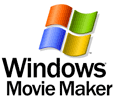

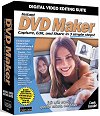
- Microsoft's Movie Maker 2 for Windows XP is not just a full-featured
consumer video editor. It also suggests a new mode for accessing and working
with video, in which you save all your video clips on your hard disk to organize
and edit, much like you do with digital photos.
- Sony's Screenblast Movie Studio also breaks away from the
traditional video editing process by using Sony's film expertise to bring movie
making fun to home movies. With this product, Sony assumes that digital
camcorders and video capture are a solved problem for consumers, so that all
that Sony needs to provide is the software.
- Topics Entertainment, a mass-market software and audio distributor,
introduced two new products, Instant Video CD Maker and Instant DVD
Maker, through their mass-market distribution channels. This really is
amazing progress -- DVD authoring in a box is now an impulse buy in the checkout
lane at Wal-Mart!
In this article, we'll look at these three products as examples of how
computer digital video and DVD are breaking out from the traditional focus on
technical features and functions to a more mass-market approach to become part
of the consumer lifestyle.
As Microsoft beefed up the video and audio capabilities of the Windows
platform in recent years, it has focused on the Windows Media format and
platform, including media players and Web servers. While Apple has developed
convenient and impressive built-in consumer tools including iMovie and iDVD, the
standard Windows platform has been limited to the basic Windows Movie Maker
video editor.
Introduced with Windows Millennium, Movie Maker was originally focused only
on creating web video in Windows Media format, and did not support full-quality
DV editing or a full suite of video editing tools. The Movie Maker for XP 1.2.1
update in August 2002 added support for higher-resolution DV editing.
Windows Movie Maker 2 for Windows XP, released in a beta version in
November 2002, then goes several giant steps further as a full-featured tool for
consumers (www.microsoft.com/windowsxp/moviemaker).
It is available as a free download for Windows XP users.

First, Movie Maker 2 adds a full assortment of editing tools, including
nearly 30 video effects, 60 video transitions, and over 40 titles and credits,
with real-time preview of transitions and effects. It supports video capture
from analog and DV devices, editing in a storyboard or timeline mode, and
exporting in a variety of video and Web formats.
The interface also has been dramatically changed, with a side Task menu to
step through the editing process -- Capture Video, Edit Movie, and Finish Movie.
Movie Maker then provides new Capture and Save wizards to assist with the tricky
parts, and a wide assortment of pre-defined Capture and Publishing profiles for
input and output formats, from DV to high-res Windows Media to Web to PocketPC
resolutions. It also provides directly-accessible Movie Making Tips for common
operations.
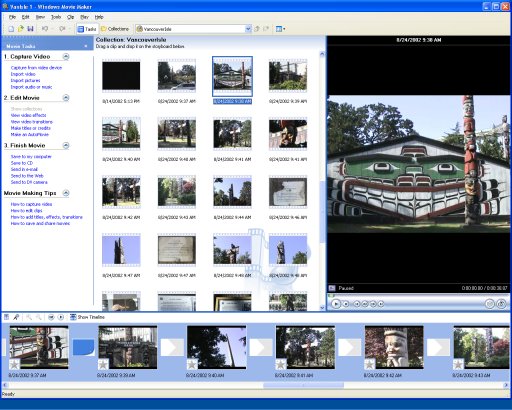
Most importantly for DV camcorder users, Movie Maker 2 provides complete
support for DV-AVI format (DV data in AVI files). You can capture directly from
digital camcorders to DV format, edit and save DV-AVI files, and export directly
back to DV cameras. You also can capture to DV and export in other formats, or
capture in Windows Media format but then export to DV, especially to transfer
your productions to a DVD authoring tool (Movie Maker does not export directly
to MPEG).
To help organize your video, Movie Maker 2 can perform clip detection after
it captures your video, either using the recording time information with DV
input, or by analyzing the video frames for scene changes. You then can organize
your clips in the Collections menu for convenient drag and drop editing, along
with the Video Effects and Transitions. You also can import and manage digital
photos, audio narrations, and WMA and MP3 audio clips.
To further simplify editing, Movie Maker 2 adds a new AutoMovie function.
Similar to the concept introduced in Muvee autoProducer (www.muvee.com),
AutoMovie analyzes the video and audio content of your movie, and automatically
edits your movie down to a highlight video, complete with titles, transitions,
and effects.
AutoMovie works by first analyzing the motion and lighting to find the
best-looking sections representative of the scenes in your source video. It then
cuts the video to the selected style, such as highlight, music video (quick
edits), old movie (aged effect) or sports highlights. For the audio, you can
choose to blend the original soundtrack with an optional background audio track,
or even to totally replace the original sound to make a music video.
In one of my tests, for example, Movie Maker cut a 25 minute vacation tape
down to a snappy highlights movie of only 3 minutes and 15 seconds. The selected
scenes were quite representative of the various locations where we shot the
tape, and of good quality (not shaky or out of focus). It even seemed to pick
out the segments where the camera lingered on a sign so you could read the text.
If you are happy with the AutoMovie result, you can simply export the movie
and be done with it. Or, much like Roxio VideoWave Movie Creator (www.roxio.com),
you can switch between automated and more hands-on editing modes. Movie Maker 2
places the result of the AutoMovie analysis in the storyboard, complete with
trimmed clips and transitions, so you then have the ability to edit and tweak it
further. Even if you plan to do some extensive editing, this can be a great
time-saver in getting started with trimming down your material.
Movie Maker 2 takes advantage of Microsoft's latest video compression
advances in Windows Media 9 to offer high-quality compression profiles at 1.5
and 2.1 megabits per second. Microsoft's concept is that you can capture
virtually lossless full-resolution 720 x 480 video at 2 Mbps, which requires
around 15 megabytes per minute. This compares to typical MPEG-2 compression
rates at around 4 to 6 Mbps, or DV format at 30 Mbps, or around 180 MB/min.
While 60 minutes of video in DV format will overflow a 10 GB disk drive, with
these kinds of Windows Media formats you can fit over twelve hours of video in
the same 10 GB.
This kind of compression permits a totally new approach to dealing with
video. The problem with video has always been that it just takes up too much
space, so you need to spend considerable effort juggling disk space and
pre-planning which clips you are going to capture and edit. This naturally
inhibits your creativity and fun, and tends to limit most weekend editors to
only taking on short clips.
Microsoft's model with Movie Maker 2 is to follow the example of digital
photography, where virtually lossless JPEG compression permits us to store all
our photos in albums on disk, so they are readily accessible at all times. In
the same way, the combination of advanced video compression, clip detection, and
automated movie creation can make our video libraries much more accessible by
allowing us to save and organize hours of video on disk.
Currently, high-end tools are designed to edit in relatively uncompressed
formats like DV, and use timecode-based batch capture to re-import clips from
tape when needed. Editing in compressed formats like MPEG has always been
discouraged, both because it is tricky to edit individual frames in a compressed
sequence, and because re-compressing material that has already been
significantly compressed can cause visible artifacts. But for simple edits such
as trimming the ends of a clip, and for final edits such as transitions and
titles, working with compressed material can make great sense.
Editing compressed video is becoming more common, with devices that capture
directly in MPEG format, as part of assembling clips in DVD authoring tools, and
in stand-alone video editors that are designed to work with formats such as MPEG
and Windows Media. We can expect this trend to continue, which will make working
with large collections of digital video much more manageable. Movie Maker 2
demonstrates how this new model can make video editing much more approachable
for the mass market.
One indication of how far digital media has come from its professional and
enthusiast days is the arrival of mass-market products on retail shelves this
past holiday season. For example, Sony Screenblast (www.screenblast.com)
has expanded its product offerings from the Screenblast Web site to add two
retail software suites in October 2002, the Screenblast Movie Studio for video (SRP
$69) and Screenblast Music Studio for audio ($69).

Sony developed the Screenblast Web site to promote the use of digital media
to create, enhance, and share video and audio productions (preferably shot with
Sony camcorders, edited on Sony PCs, and played on Sony consumer electronics
products). From the Screenblast site, Sony offers a variety of individual video,
image, and audio editing tools for prices ranging from $29 to $69 for downloads.
These include the Screenblast VideoFactory video editor ($69), Image Editor for
photos ($39), SoundForge audio editor ($69), ACID for audio loops and effects
($69), and the SIREN Jukebox multimedia library ($29). The entire set of tools
also is available for $159, and free trial versions are available on the Web
site.
As you may have noticed from the names, several of these applications are
derived from Sonic Foundry (www.sonicfoundry.com)
products. Sony has enhanced the Screenblast products and suites with integrated
tutorials, enhanced user interfaces for easy import and export, web integration
for posting clips on a personal Web page at Screenblast.com, and large
collections of sample clips.
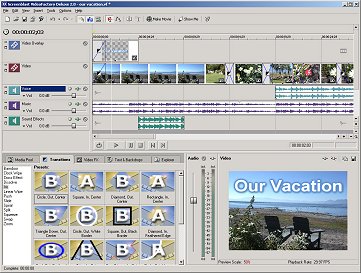
The Screenblast Music Studio suite includes Screenblast ACID Deluxe and SIREN
Jukebox, and the Screenblast Movie Studio suite is based on the Screenblast
VideoFactory video editor. VideoFactory offers extensive editing capabilities
including DV capture, hundreds of effects and transitions, RealMedia and Windows
Media support, and unlimited undo/redo. It also adds one-click publishing to the
Screenblast Web site and burning to data and video CD.
But Sony's real emphasis is on making video editing creative and fun. The
integrated tutorials can get you going quickly, and the CD includes a wide
assortment of video clips, illustrations, borders, and titles. In addition, Sony
is bringing its Hollywood connections to consumer editing through ideas and
clips from Sony Pictures. The Screenblast site includes an "Extras"
section, with movie-making tips from directors and fun themes and movie clips,
including action scenes from "Iron Eagle," sports from "Jerry
Maguire" and "The Natural," and even shore footage from
"Dawson's Creek."
What is so interesting about the new Screenblast retail products is what it
reveals about Sony's view of the consumer market. The Screenblast products such
as VideoFactory assume both a relatively computer- and video-literate user, and
that the users already have the appropriate equipment, including a digital video
camcorder, relatively recent PC, and a FireWire interface. The Screenblast
experience also is dependent on users having a broadband Internet connection,
both for downloading fun clips and for uploading and sharing clips on the
Screenblast Web site. Sony is deliberately providing tools with a broad array of
features and options, using the tutorial to help get users started, and then
providing stair-steps to advanced uses.
Another approach to mass-market digital media comes from Topics
Entertainment (www.topics-ent.com),
which publishes over 200 educational software and spoken word audio products.
Its titles in language, education and reference software include names such as
Rand McNally, The Audubon Society, World Book Encyclopedia, and National
Geographic, and its products are available at major retailers including Barnes
& Noble, Best Buy, Circuit City, Sam's Club, Staples, Target, and Wal-Mart.
In October 2002, Topics entered the digital video market with two DVD
authoring packages, Instant DVD Maker ($59.99 MSRP) and Instant Video
CD Maker ($49.99). The Video CD product supports digital capture (not
analog), and export to CD, VCD, and SVCD (not DVD).


These products include seven digital video applications developed by Honest
Technology (www.honestech.com),
organized as the DVD Plus 2.0 suite. Each of these tools is independent, and can
be used stand-alone, or to process files created by the other tools as part of
the capture - compress - edit - author workflow.
In mini-screen mode, the DVD Plus control panel offers one-click access to
the authoring tools, and a scrolling photo and video album. In full-screen mode,
it morphs into the Digital Album tool, which you can use to access the Photo
Editor tool. These provide basic capabilities for reviewing clips and enhancing
photos.
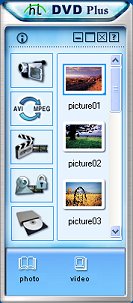
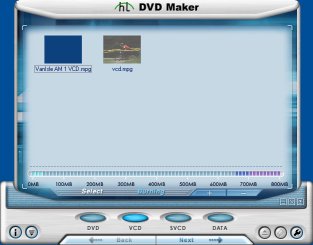
For DVD authoring, the suite includes separate tools for capture,
compression, editing, and burning: Digital Video Recorder, MPEG Encoder, MPEG
Editor, and VCD / DVD Maker. These offer nice presets for standard formats (VCD,
SVCD, DVD), as well as the ability to work end-to-end in the appropriate MPEG
format. The suite also includes a Video Surveillance security tool.
While the DVD Plus interface is mostly pleasantly designed, these tools are
not overly consumer-friendly. The manual and help files are thin and choppy, and
the controls are an inconsistent mix of large and small, icons and text. More
importantly, this is not automated authoring, so you need to manually step
through the authoring process, and understand and keep track of which formats
you should be using along the process.
For the appropriate user, however, these tools do provide a nice workflow,
direct control over each stage of the process, and very helpful information
displays about file types and formats. You can try out demo versions of the
individual tools from the Honest Technology web site.
These three new products from the past holiday season mark the beginnings of
a transition of digital media from enthusiast tools to mass-market fun.
With Screenblast, Sony is moving video editing from utility to entertainment,
to something fun to do every day instead of only for special events. With
Instant DVD Maker, Topics Entertainment is bringing Video CD and DVD authoring
to the broad retail market. And with Movie Maker 2, Microsoft is positing video
editing like photo editing as a base Windows feature that permits you to have
all your material at hand to access and share whenever you want.
Just as digital photography has taken off as a better way to make photography
a more fun and interesting experience, and digital audio makes your music more
personal and enjoyable, digital video is going mainstream. Attention shoppers:
DVD burning special in aisle 3!
Microsoft - Movie Maker 2
www.microsoft.com/windowsxp/moviemaker
Topics Entertainment - Instant DVD Maker
www.topics-ent.com
Honest Technology
www.honestech.com
Sony - Screenblast Movie Studio
www.screenblast.com
Sonic Foundry
www.sonicfoundry.com
Muvee autoProducer
www.muvee.com
Roxio VideoWave Movie Creator
www.roxio.com
|
